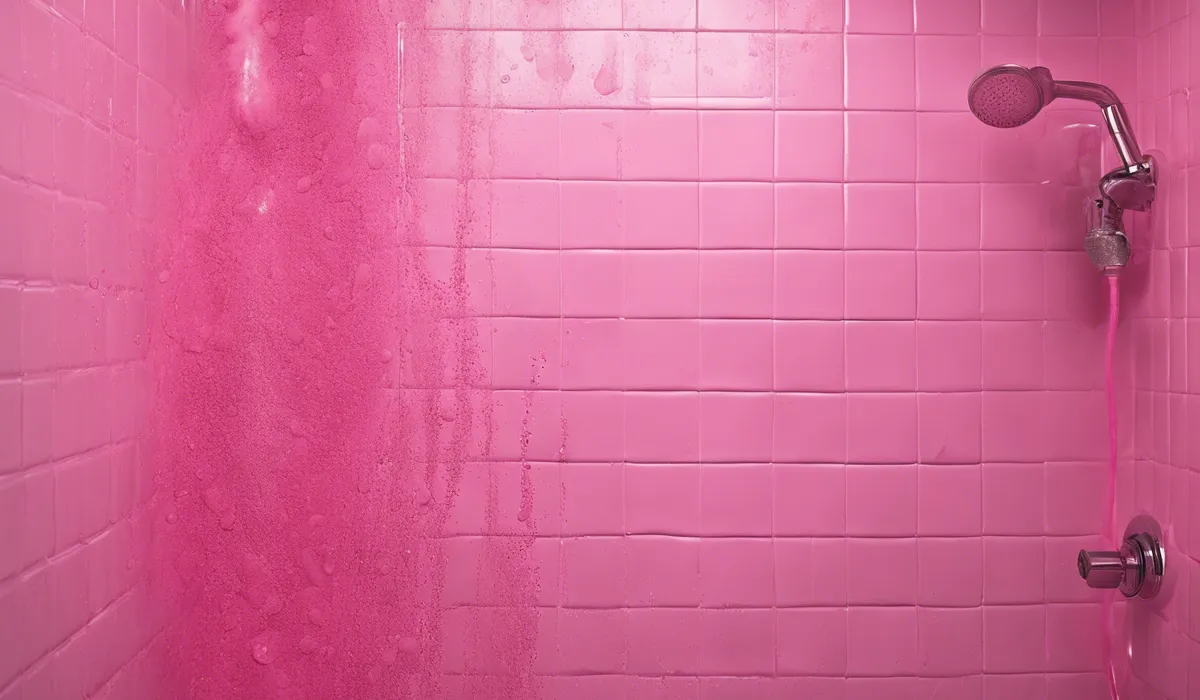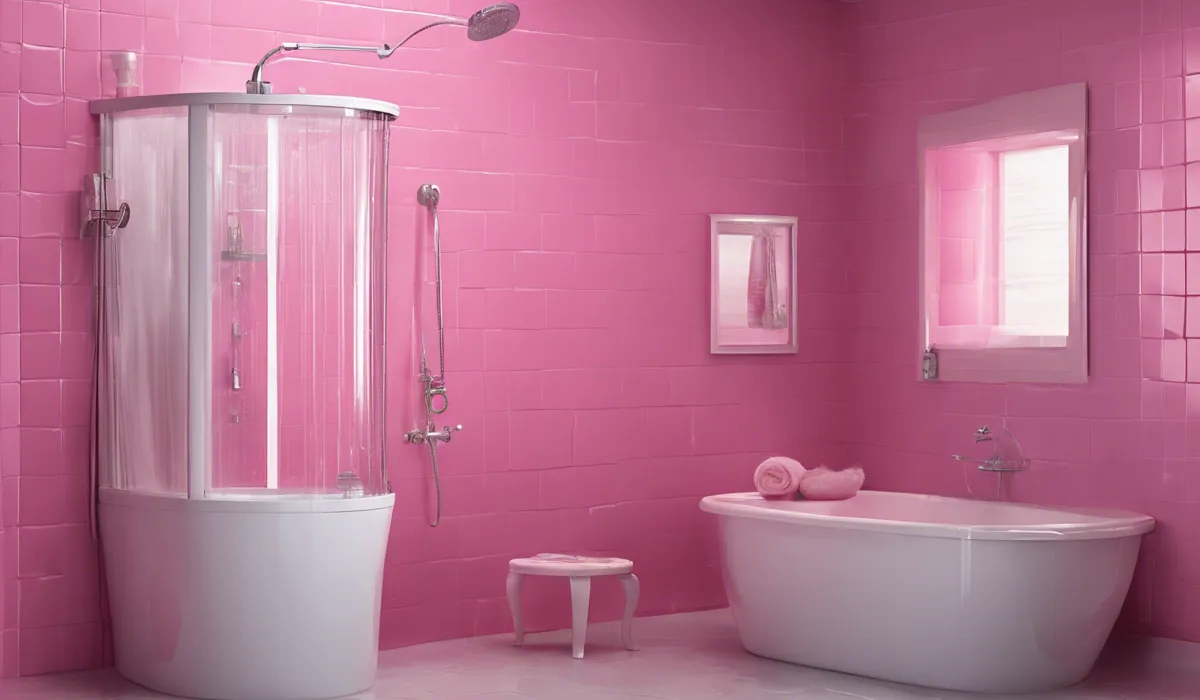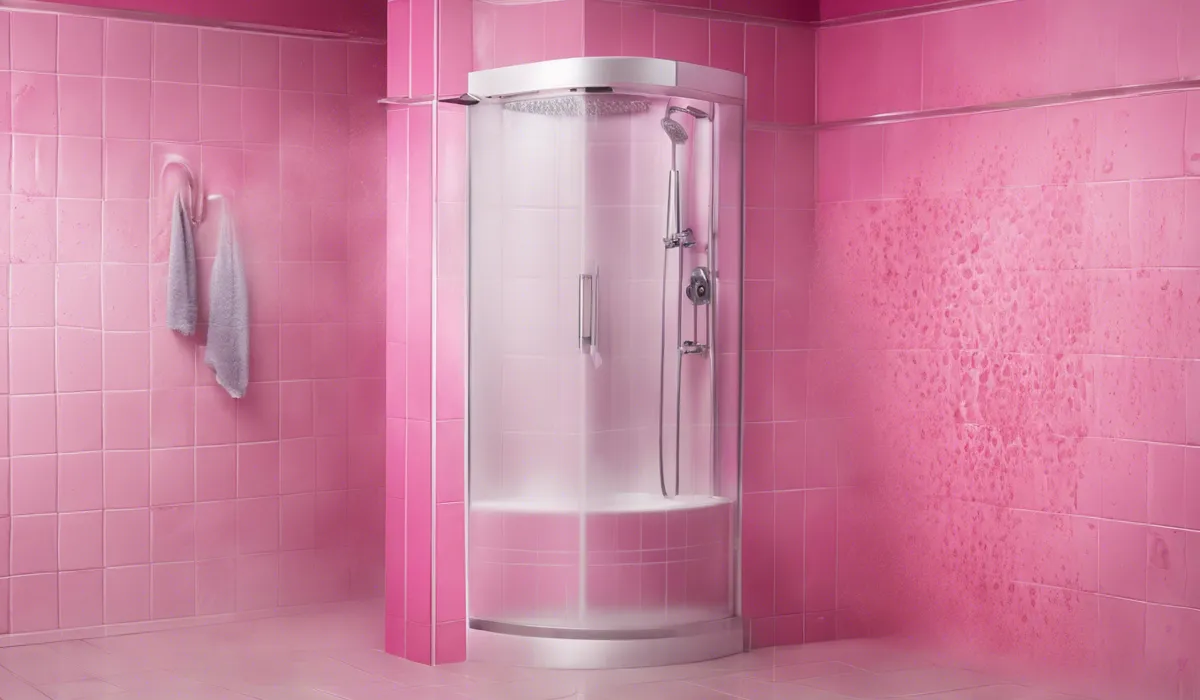To prevent pink mold in showers, regularly clean with a bleach-based solution, ensure good ventilation to reduce moisture, use a squeegee after showers, and promptly repair leaks to keep surfaces dry.
Understanding Pink Mold

Definition of Pink Mold
Pink mold is not actually mold, but a common name for a bacteria called Serratia marcescens.
This bacteria thrives in moist environments and appears as a slimy or fuzzy substance that can range in color from pink to red.
It’s often found in bathrooms, particularly in showers, because they offer the perfect breeding ground with plenty of water and organic material for the bacteria to feed on.
Common Causes of Pink Mold in Showers
Pink mold in showers can stem from various sources. Soap and shampoo residue, combined with the warmth and moisture of a shower, create an ideal setting for Serratia marcescens to grow.
Poor ventilation that leaves surfaces wet for extended periods also contributes to the problem.
Furthermore, infrequent cleaning schedules allow for the accumulation of the organic matter that feeds the bacteria, enabling it to flourish.
Health Risks Associated with Pink Mold
While most people may not have severe reactions to pink mold, it can cause health issues, especially for those with weakened immune systems, respiratory problems, or allergies.
The bacteria can lead to infections, respiratory complications, and skin irritation. Ensuring that pink mold is kept at bay is important for maintaining a healthy living environment.
Preventative Measures

Daily Maintenance and Cleaning Habits
To prevent pink mold, daily maintenance is crucial. After each shower, use a squeegee to remove water from the walls and floor.
This reduces the moisture that bacteria need to grow. Additionally, weekly cleaning with a bleach-based solution will kill any early growths of bacteria. A consistent cleaning routine prevents pink mold from taking hold in your shower.
Appropriate Materials and Shower Products
Choosing materials that resist moisture can help prevent pink mold. Opt for shower curtains and liners that are mildew-resistant.
Also, consider using bath products that are less likely to leave residue, such as liquid soaps, and ensure that you rinse away any soap scum thoroughly after use.
Ventilation and Humidity Control
Good ventilation is key in the fight against pink mold. Install an exhaust fan in your bathroom if you don’t already have one, and make sure to run it during and after showers to reduce humidity levels.
Keeping windows open when possible can also help. Using a dehumidifier can further control moisture levels in the bathroom, making it less hospitable to bacteria.
Treatment Solutions

Natural Cleaning Agents for Pink Mold Removal
If you’re facing a pink mold problem, natural cleaning agents can be an effective and safe way to remove it.
Vinegar, for instance, can kill many bacteria and is non-toxic. A solution of vinegar and water can be sprayed onto affected areas.
Let it sit for some time, then scrub gently and rinse away. For tougher spots, baking soda can be used to scrub the mold away before the vinegar application.
Chemical Cleaners and Their Usage
For more persistent pink mold, chemical cleaners may be necessary. A bleach solution is commonly used to kill bacteria and mold.
It’s important to follow the manufacturer’s instructions when using chemicals and ensure the bathroom is well-ventilated during cleaning.
Always wear protective gloves and avoid mixing different cleaners, as this can cause dangerous reactions.
When to Seek Professional Help?
If you’ve tried both natural and chemical treatments and the pink mold persists, it may be time to seek professional help.
Professionals have access to stronger treatments and can assess if there are underlying issues contributing to the growth, such as hidden leaks or structural problems.
Don’t hesitate to call in experts to ensure your bathroom is safe and healthy.
FAQs About Preventing Pink Mold in Shower
How often should I clean my shower with bleach to prevent pink mold?
Clean your shower with a bleach-based solution at least once a week to prevent pink mold.
What type of ventilation is best to reduce moisture and prevent pink mold in my shower?
Good ventilation can be achieved by using an exhaust fan or opening a window to reduce moisture in the bathroom.
How does using a squeegee after showers help in preventing pink mold?
Using a squeegee helps remove water from the shower surfaces, reducing moisture and making it less hospitable for pink mold to grow.
How quickly should I repair leaks to prevent pink mold in my shower?
Promptly repair any leaks to keep shower surfaces dry and inhibit pink mold growth.
Can pink mold reappear after cleaning, and how do I prevent it?
Pink mold can reappear if the conditions remain favorable for its growth; maintain regular cleaning, ensure proper ventilation, and keep surfaces dry to prevent its return.
Final Thoughts
To fend off pink mold in showers, it’s essential to maintain regular cleaning with bleach-based cleaners.
Adequate ventilation is crucial to minimize moisture, alongside using a squeegee post-shower. Promptly addressing any leaks ensures surfaces remain dry, further deterring mold growth.
